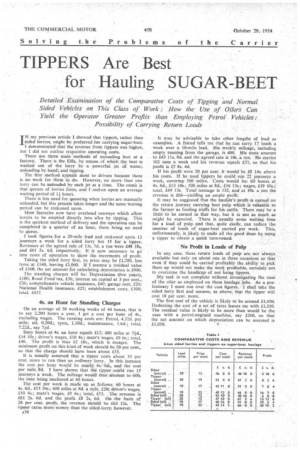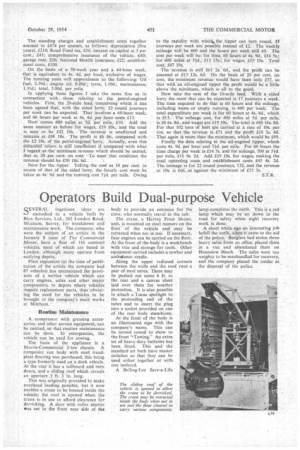TIPPERS Are Best for Hauling SUGAR-BEET
Page 62

Page 65

If you've noticed an error in this article please click here to report it so we can fix it.
IN my previous article I showed that tippers, rather than sided lorries, might be preferred for carrying sugar-beet.
I demonstrated that the revenue from tippers was higher, but I did not outline respective operating costs.
There are three main methods of unloading beet at a factory. There is the Elfa, by means of which the beet is washed out of the lorry by a powerful jet of water; unloading by hand; and tipping.
The first method appeals most to drivers because there is no work for them to do. However, no more than one lorry can be unloaded by each jet at a time. The result is that queues of .lorries form, and I reckon upon an average
waiting period of if hours. '
There is less need for queueing when lorries are manually unloaded, but this process takes longer and the same waiting period can be reckoned upon.
Most factories now have overhead runways which allow lorries to be emptied directly into silos by tipping. This is the quickest method of delivery and the operation can be completed in a quarter of an hour, there being no need to queue.
I took figures for a 20-mile lead and reckoned upon 12 journeys a week for a sided lorry but 15 for a tipper. Revenues at the agreed rate of 13s. 7d. a ton were £48 18s. and £61 2s. 6d. respectively. It is now necessary to go
• into costs of operation to show the increments of profit.
Taking the sided lorry first, its price may be £1,200, less tyres at £140, leaving £1,060. If I assume a residual value of £160, the net amount for calculating depreciation is £900.
The standing charges will be: Depreciation (five years), £180; Road Fund tax, £36; interest on capital at 3 per cent., £36; comprehensive vehicle insurance, £40; garage rent, £20; National Health insurance, £25; establishment costs, MOO; total, £437.
4s. an Hour for Standing Charges On an average of 50 working weeks of 44 hours, that is to say 2,200 hours a year, I get a cost per hour of 4s., excluding wages. The running costs are: Petrol, 4.32d. per mile; oil, 0.20d.; tyres, I.10d.; maintenance, 1.6(1.; total, 7.22(1_, say 71d.
Sixty hours at 44. an hour equals £12; 480 miles at 7id., £14 10s.; driver's wages, £10 4.; mate's wages, £9 6s.; total, £46. The profit is thus £2 18s., which is meagre. The minimum profit on this kind of work should be 20 per cent., so that the charge should have been about £55.
It is usually assumed that a tipper costs about 10 per cent, more to run than an ordinary lorry. In this instance the cost per hour would he nearly 4s.-6d., and the cost per mile 8d. I have shown that the tipper could run 15 journeys a week. The mileage would thus arnciuM to 600, the time being unaltered at 60 hours.
The cost per week is made up as follows: 60 hours at 4s. 6d., £13 10s.; 600 miles at 8d. a mile, £2* driver's wages, 110 4s.; mate's wages, £9 6s.; total, £53. The revenue is £.61 2s. 6d. and the profit £8 2s. 6d. On the basis of 20 per cent, profit, the revenue should be £63 12s. The tipper earns more money than the sided-lorry, however.
a3L6
It may be advisable to take other lengths of lead as examples. A friend tells me that he can carry 17 loads a week over a 10-mile lead. His weekly mileage, including empty running from the garage, is 400. His costs amount to £43 its. 8d. and the agreed rate is les. a ton. He carries 102 tons a week and his revenue equals £51, so that his profit is £7 8s. 4d.
If his profit were 20 per cent, it would be £8 14s, above his costs. If he used tippers he could run 22 journeys a week, covering 500 miles. Costs would be: 60 hours at 4s. 6d., £13 10s.; 500 miles at 8d., £16 13s.; wages, £19 10s.; total, £49 13s. Total tonnage is 132, and at 10s. a ton the revenue is £66-yielding an ample profit.
It may be suggested that the haulier's profit is earned on the return journey carrying beet pulp which is valuable to the farmer as feeding stuffs for his cattle. There may be a little to be earned in that way, but it is not as much as might be expected. There is usually some waiting time for a load of pulp and that, quite easily, cart reduce the number of loads of sugar-beet carried per week. This, unfortunately, is likely to undo all the good done by using a tipper to obtain a quick turn-round.
No Profit in Loads of Pulp In any case, these return loads of pulp are not always available but only on about one in three occasions so that even if they could be carried profitably the ability to pick them up would not make the work profitable, certainly not to overcome the handicap of not using tippers.
My task is not complete without investigating the ease of the oiler as employed on these haulage jobs. As a preliminary I must run over the cast figures. I shall take the sided lorry first and assume, as above, that the tipper will cost 10 per cent. more.
The first cost of the vehicle is likely to be around £1,450. Deducting the cost of a set of tyres leaves me with £1,3.10. The residual value is likely to be more than would be the case with a petrol-engined machine, say £260, so that the net amount on which depreciation can be assessed is £1,050.
The standing charges and establishment costs together amount to £474 per annum, as follows: depreciation (five years), £210; Road Fund tax, £36; interest on capital at 3 per cent., £43; comprehensive insurance of the vehicle, £40; garage rent, £20; National Health insurance, £25; establish
ment costs, £100. .
On the basis of a 50-week year and a 44-hour week, that is equivalent to 4s. 4d. per hour, exclusive of wages. The running costs will approximate to the following: 'Oil fuel. 2.39d.; engine oil, 0.20d.; tyres, 1.10d.; maintenance, 1.31d.; total,5.00d. per mile.
In applying these figures I take the same line as in connection with.. those relating to the petrol-engined vehicles. First, the 20-mile lead, concerning. which it has been agreed that, with the sided lorry, 12. round journeys per week can be expected. That involveS.a 60-hour week,. and 60. hours per week at 4s. 4d.yer hour costs £13. Next comes 480 milesat .5d: per mile, £10. Add the . same amount as before for Wages, £19 10s., and the total is seen to be' £42 £42 10s. The revenue is unaffected and remains at 148 18s. The profit is £6 as:, compared with the a 18s. of the petroPengined lorry. Actually, even this enhaneed.retiarn is still insufficient if compared 'with what Fregard. as the' minimum revenue which should be earned, that is, 20 per, cent. on .cost TO. meet that condition the reVenue: should be :150 18s. 6d. .
Now for the tipper-. Taking the cost as 10 per cent. in excess of that of the .sided -lorry, the ..hourly .cost must be taken as 4s. 9d: and the.runnin-g cost 54(1. per mile. Owing to the rapidity with whiclae the tipper can turn round, 15 journeys per week are possible instead of 12. The weekly mileage will' be 600 and the hours per weekstill 60. The cost per week will be: for time, 60. hours at 4s. 9d., £14 5s.; for 600 miles at 5-id., £13 15s.; for wages, £19 10s. Total cost, £47 10s.
The revenue is still £61 2s. 6d., and, the profit can he assessed at £13 12s. 6d. On the basis of 20 per cent, on cost, the minimum revenue would have been only £57, so' that with an oil-engined tipper the profit would be a little above the minimum, which is all to the good.
Now take the •case of the 10-mile lead. With a sided. lorry the mostthat can be expected is 17 journeys a week. The time required to do that is 60 hours and the mileage, including waste or empty running, is 400 per week. The totalexpenditure per week is for 60 hours at 4s. 4d., which is 113. The 'mileage cost, for 400 miles at 5d.. per mile,' is £8 6s. ad., and wages are £19 10s. The total is £40 16s:8d. For that 102 'tons of beet are carried at a rate of 10s. per ton, so that the revenue is £51 and the profit £10 3s. 4d. That again is more than the minimum, which would be £49.. Finally the data relating to the oil-engined tipper, which costs :4, 9d. per hour and 54d. per mile. For 60 hours the time charge per week is £14 5s. and for mileage, 500 at 54d. per mile, £11 9s. 2d. Add £19 10s. for wages, making the total operating costs and establishment costs £45 4s. 2d.. The tonnage is for 22 round journeys, 132, and the revenue at 1.0s. is £66, as against the minimum of .£55 5s.




























































































